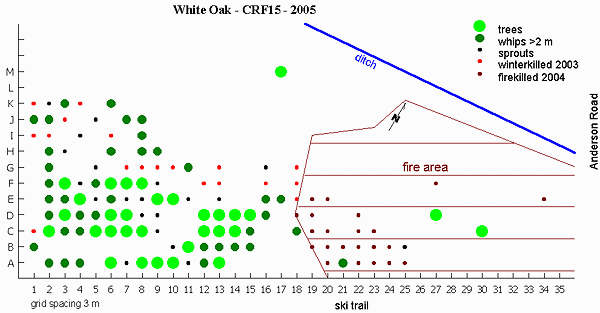Understanding of this has been slow in coming. First came Plant Hardiness Zones. Great arching stripes of colour, wiggly and patchy over mountains, wending their way grandly across the continent from coast to coast, they divided Canada into ten areas based solely upon the coldest winter temperature. Right behind came the nursery catalogues, many of which still declare "Quercus macrocarpa. A native oak. Zones 2 to 9". Intended translation: "you can grow this tree from our nursery everywhere in Canada except on the tundra". And, although the current Canadian version of the hardiness zones takes additional factors into account (Can. J. Plant Sci. 47:339-358), the concept has not changed. Nor have most nursery catalogues.
But, many geographic factors other than winter temperature are critical to the growth cycle of trees: growing season, rainfall, day length, wind, soil type and drainage, snow depth, herbivore types.... In fact, for most conifers the coldest temperature is not even the primary factor in growth success (Plant Cold Hardiness Symp. 2:437-446), except above the mountain tree line isotherm of -40C (PCHS 2:307-324). Mid-latitude trees must have a long delay between the first warm spell and start of growth, to avoid setback by late frost, while trees adapted to high-latitude must have a short delay to fully use the brief growing season (PCHS 5:317-323). A widely accepted start of tree growth is 5 consecutive days above 5C (Canadian Journal of Forestry Research 26:333-354) - Ottawa's last frost can be a month later than that.
So, a tree grown from seed adapted to Iowa may survive near Ottawa, but it is unlikely to grow its best. Yet, most of the trees carried in Ottawa stores began life in the mid-USA, and had a stopover in a nursery near Toronto.
In an attempt to fit the adaptive limits of softwood trees better than the nursery catalogues do, the province of Ontario established Seed Zones based on temperature and precipitation. Unfortunately, their process fell prey to computer numerology - the data fitting was to 3-sigma, but the plant response factors used were judgemental, had no significance measures available and were unlikely to be valid as used (CJFR 26:333-354). So, there were initially far more Ontario seed zones than were supported by the underlying science. Fortunately, this has now been corrected; the current zone system is at the 1-sigma level.
Just west of the Mer Bleue bog in Ottawa, a hundred experimental plantations of trees were seeded in the decade following Centennial Year, 1967, as a Central Research Forest. For a variety of reasons, the project was abandoned in 1979. Now, in the Millennium Year, 2000, I am beginning to study them, to learn what I can from them, and to improve their contribution to local biodiversity. One of my first studies is of two plantations of white oak (Quercus alba), one on a low lying area just to the north of the Dolman Ridge, the other on the ridge itself.
The forester who collected seed for the CRF, Moe Anderson, showed me the site where the white oak seed was collected: the sheltered side of a rocky ridge near Morton Ontario (44°33'N 76°10'W) where he was collecting pitch pine (Pinus rigida). The sparse coarse soil about the oaks is very wet, with flowing water at the surface much of the year, but drainage is sharp. The water table is about 3 m below the surface and maintained there by a large flat area and a stream.
The frost hardiness of white oak as a species is zone 4, Morton and Ottawa are both in zone 5 and, at 120 km, are well within Cooper distance (which also is judgemental and has no significance measures established - see his paper in the Journal of Soil and Water Conservation 12:163-168). However, while as a species white oak has a fairly broad amplitude as to the sites on which it performs acceptably, individual populations are often highly selected (K.Farr, personal communication).
Of 530 seedlings planted in 1976 on the lowland, only 28 survived as trees by 2000. Many display repeated frost splitting, repeated dieback of shoots, and an excessive attractiveness to yellow-bellied sapsuckers (Sphyrapicus varius). 60 have died back to the ground at some point, at up to ten years of age, and have been eaten back to sprouting roots by voles (Microtus pennsylvanicus) ever since. (There is little damage from rabbits, as they are avidly sought by the small pack of coyote resident on the east end of the ridge.) The plantation on the ridge has no sapsucker holes, no frost splitting, and little dieback. The trees on the lowland have good crops of acorns, those on the ridge virtually none. The temperature and precipitation are the same for each plantation - the ridge is only 5 m high. The water table of both averages 1 m below the surface.
What is different? At first glance: the soil. The ridge is very high in sand (it was a sand bar in the glacial Ottawa river), while the lowland is almost pure Champlain Sea clay. But, according to U.S. experts, soil factors have little effect on white oak growth - site topography is found to be more important. The voles ate almost all the tree competition at the lowland site, leaving the trees exposed to north winds, while the ridge oaks were significantly sheltered by white birch and an adjacent plantation of red oak.
So, the Morton trees are having problems adapting to both sites. Can white oak grow well here at all given the exposure? Or, is the primary impediment the voles? If the latter, are the voles simply choosing weak trees or are they creating their own ecology? (The more the oaks are eaten back, the later they sprout, and the more tender and numerous the shoots they produce for vole food the next winter.)
To provide a few answers, I've started some experiments:
- Two of the trees are fully exposed yet are growing well. While they have some frost splitting, they have had less shoot dieback than most and retain reasonably good growth and form. One (D30) set seed in 2000, although I had to collect it early to beat the blue jays. The seedlings will be planted at sheltered and exposed sites on the lowland, as one first generation selection from the Morton seed.
- I also collected seed from the tree (E3) that has consistently recovered best from shoot dieback by self-pruning to a primary leader, although it has had more dieback than the first two.
- One tree (M17) is growing right at the edge of the drainage ditch, in the wettest and most exposed position of any of the surviving trees. It is growing at about half the rate of the other trees, but has acceptable form and must be very resistant to root flooding. It set seed in 2001, and propagation is in progress.
- 24 trees have been girdled by voles in the past, but currently have a primary shoot more than two years old. I have removed all vole shelter and excess shoots from these, and will protect most for the next few winters with tar paper, to see whether the voles or winter hardiness are the primary limitation to their survival.
- 36 roots are still alive but no longer have a primary shoot. I have clipped surrounding vegetation from some of them, and am pinching off some of the excess shoots from some others, to see if increased exposure to sun and wind (hardening) or growth strength decreases vole damage.
The results of the first winter (2000-1) indicated that voles might have been the primary problem. No tree guarded with tar paper that winter suffered any damage under the paper. Several that were not guarded high enough were girdled above the paper. Most of the unguarded ones up to ten years old were destroyed by girdling.
During 2001, a careful search through the raspberry patches uncovered several more trees. For the winter 2001-2, most of the shoots were protected with plastic spiral guards to a height of 1 m (the usual snow depth on the site). There seem to have been few voles active over this winter, as the shoots left unprotected showed essentially no damage. One 'protected' shoot was killed - it was so small that the plastic did not close around it, and a vole was able to crawl between the plastic and shoot.
During 2002 and 2003, little change took place. The trees were protected as in 2001, the vole population remained low, and no losses were noted except for L22, which was destroyed by a beaver in 2002.
The winter of 2003-4 saw the first winter kills since observations began, of some of the small exposed trees. Again, there was little vole damage even to unprotected trees. With protection, many of the sprouts have reached whip height.
On 16 April 2005 a grass fire swept a third of the plantation area before being extinguished by the Ottawa fire department. By July, it was evident that the fire had killed all the oak buds except for a few near the top of the two full size trees and of two of the whips. The raspberries and grass are growing fresh and green, with newly-fertilised vigour. By fall 2007, D27 has fully recovered from fire damage, but C30 has only recovered about 30% of its original leaf area. Most of the whips that were 5 cm DBH or greater have recovered; all of those less than 1 cm at the time of the fire are gone.
John Sankey
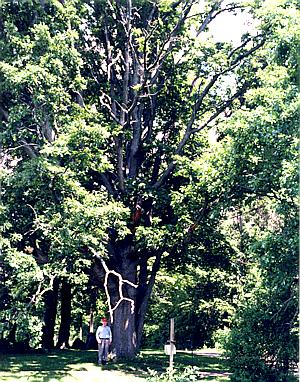
Moe Anderson at one of the Morton white oaks, spring 2000
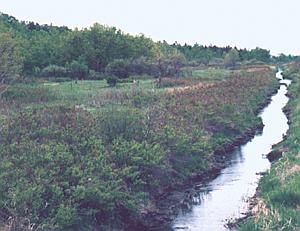
the lowland site - heavy wet soil and north exposure; not where white oaks are usually found
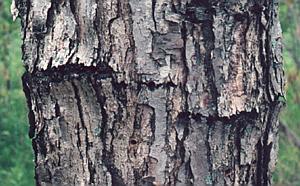
old sapsucker holes in C5
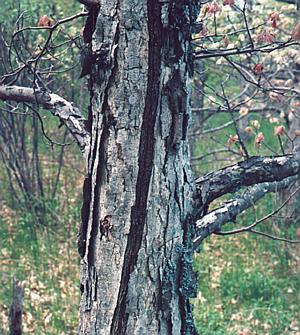
frost splitting of D12
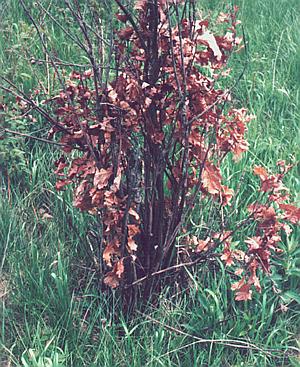
typical resprouting root as found
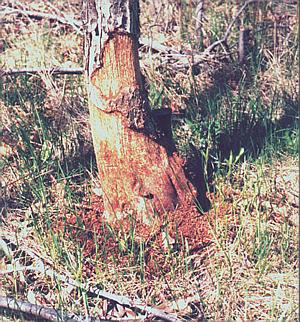
vole destruction of F2, 2000
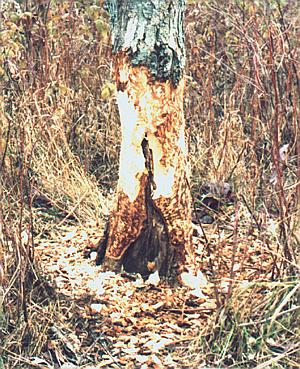
beaver destruction of L22, 2002
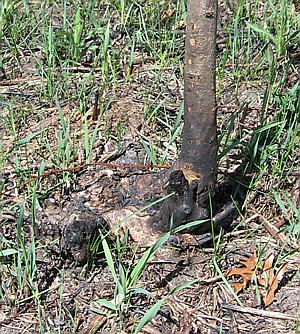
fire damage to C20, 2005
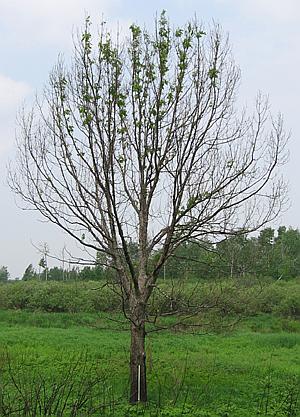
fire damage to C30, mid-June 2005
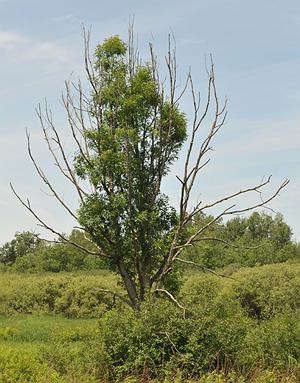
state of C30 mid-June 2010
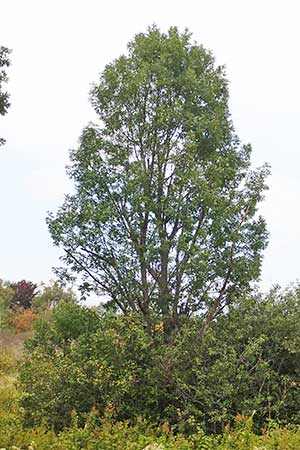
state of C30 early Sept 2017. Most of the dead branches have fallen off; although now looking
well recovered, it's half the foliage volume of D27
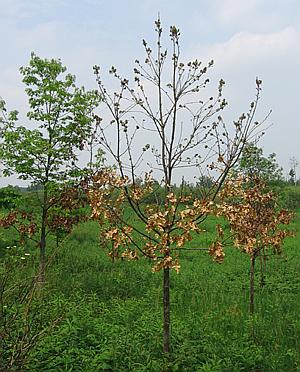
the border of the fire area June 2005: a whip just within the fire area is
sprouting only at its top, a whip to the right was destroyed, an unaffected
whip to the left is leafing normally.
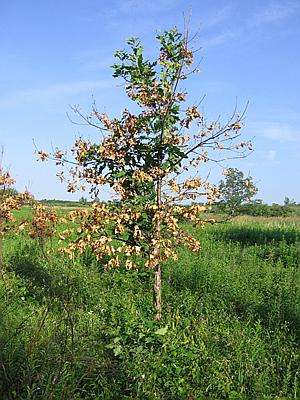
B24 recovering July 2005
